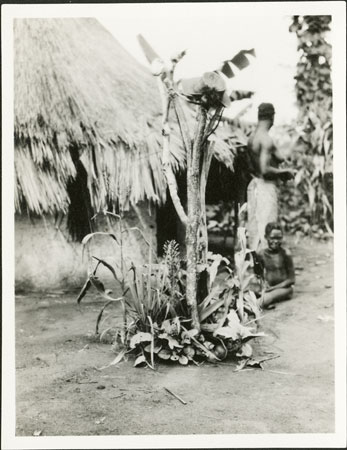Zande spirit-shrine in homestead

104 x 78 mm | Print gelatin silver
There are records relating to alternative images that we do not have scans for in the database:
1998.341.13.1 - Negative film nitrate , (104 x 78 mm)
1998.341.13.1 - Negative film nitrate , (104 x 78 mm)
Condition:
Slight edge fading [EE 1989]
Date of Print:
Unknown
Previous PRM Number:
EP.A.13a
Previous Other Number:
92 1 (40) [frame 5]
Accession Number:
1998.341.13.3
Description:
A tuka or spirit shrine near a hut with a child and woman outside.
It consists of a split stick, the ends bound at the top, with a straw hat placed within.
There are ritual offerings below alongside magico-religious plants growing around the base, such as ranga ambiri (against wild animals) and possibly also sarawa (food-medicine).
Such shrines are sites for medicines or ngua that are invoked to ensure ancestral (spirit) favour for the inhabitants of the homestead.
Photographer:
Edward Evan Evans-Pritchard
Date of Photo:
1927 - 1930
Region:
[Southern Sudan] Western Equatoria Yambio
Group:
Zande
Publication History:
Contemporary Publication - Reproduced as Plate LIXa (facing page 528) IN C.G.
& B.
Seligman's
Pagan Tribes of the Nilotic Sudan
(London, Routledge 1932), with the caption '
Tuka
, with "medicine" growing at base'.
PRM Source:
Edward Evan Evans-Pritchard
Acquired:
Donated 1966
Other Owners:
E. E. Evans-Pritchard Collection
Class:
Religion , Ritual , Ritual Object , Shelter
Keyword:
Religious Offering , Building House , Shrine
Documentation:
Original catalogue lists in Manuscript Collections. Additional material in related documents files. [CM 27/9/2005]
Primary Documentation:
PRM Accession Records - [1966.27.21] G PROFESSOR E.
E.
EVANS-PRITCHARD; INST.
OF SOCIAL ANTHROPOLOGY, 51 BANBURY RD.
OXFORD - S.
SUDAN, AZANDE TRIBE.
Box of negatives in envelopes.
Nos.
1 - 400
Added Accession Book Entry - [In pencil in column] Catalogue room.
[1966.27.23] G PROFESSOR E. E. EVANS-PRITCHARD; INST. OF SOCIAL ANTHROPOLOGY, 51 BANBURY RD. OXFORD - S. SUDAN, AZANDE TRIBE. Box of prints in envelopes, nos. 1 - 400 (prints of negatives in 1966.27.21)
Manual Catalogues [typewritten, entitled "Zande Photographs (E-P)"] - 13. Spirit shrine in homestead. (Showing medicines at its foot). 92/1 (40)
Added Accession Book Entry - [In pencil in column] Catalogue room.
[1966.27.23] G PROFESSOR E. E. EVANS-PRITCHARD; INST. OF SOCIAL ANTHROPOLOGY, 51 BANBURY RD. OXFORD - S. SUDAN, AZANDE TRIBE. Box of prints in envelopes, nos. 1 - 400 (prints of negatives in 1966.27.21)
Manual Catalogues [typewritten, entitled "Zande Photographs (E-P)"] - 13. Spirit shrine in homestead. (Showing medicines at its foot). 92/1 (40)
Other Information:
Ethnographic context - In The Azande (OUP, 1971) page 99, E.
E.
Evans-Pritchard notes that "the ordinary old Mbomu shrine is the tuka, a stake split at the top and with the split sections bound to form a recepticle for offerings." In Witchcraft, Oracles and Magic Among the Azande (OUP 1937, page 441) he also states that 'Medicines which are domesticated are planted around the ghost-shrine, and when a new shrine is erected medicines are often buried at its base and ghosts and medicines are alike addressed to ensure the welfare of the inmates of the homestead.
Likewise, when a shrine is erected in an eleusine cultivation medicines are placed around it, and both they and the ghosts are asked to protect the eleusine.
The association is here close, but the power of the medicines is not attributable to the ghosts, for the power is in the medicines.' In The Azande (London AIA, 1953 page 94) P.
Baxter & A.
Butt state that 'When a Zande establishes a new homestead he erects in the centre of it a shrine (tuka) to the spirit (atoro or atolo) of his father...
[b]efore being set up, the stake is rubbed with ashes from the new homestead's first fire and soon after its erection a sacrifice made at it.
A selection of first fruits and the liver of the first animal killed by the homestead head are usually placed in the basket, but otherwise offerings are not made regularly, except perhaps in times of dearth or adversity, or when disease is attributed to the anger of the spirits.' This account is based upon C.R.
Legae's article "Les procedés d'augere et de divination chez les Azande" (Congo, 1921, I) and so may or may not relate to practices related to the tuka shrine among the Azande of the Sudan. See also [1998.341.141] [Chris Morton 20/10/2003]
Recorder:
Christopher Morton 7/10/2003 [Southern Sudan Project]

